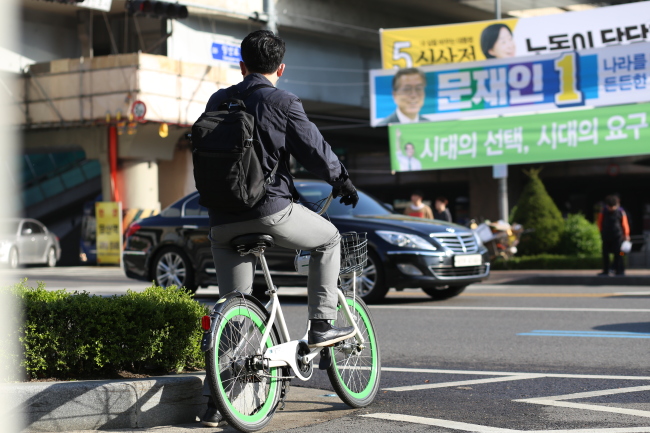[Weekender] Work -- a bike ride away
For riders, the way to work is the time for a workout
By Korea HeraldPublished : April 21, 2017 - 17:25
For urban commuters who have to scramble daily through the traffic-jammed city or spend a heavy monthly allowance on taxi rides, the low cost and less-stress alternative of taking a bicycle to work is tempting.
The idea, of course, involves a number of concerns: Do I have to purchase a bicycle and safety equipment? Is it safe to ride a bicycle on downtown main streets? What if it rains unexpectedly? Can I ride in my business attire?
The idea, of course, involves a number of concerns: Do I have to purchase a bicycle and safety equipment? Is it safe to ride a bicycle on downtown main streets? What if it rains unexpectedly? Can I ride in my business attire?

Despite such challenges, an increasing number of people have been turning an eye to the eco-friendly self-pedaled vehicle as a way to combine physical exercise and daily life.
Lee Jin-young, a 35-year-old office worker who commutes daily from Seoul’s Yeongdeungpo-gu to downtown Jongno-gu, decided to avail himself of the city’s bike-sharing system.
“The first thing I do after getting ready for work is to check on the Seoul Bikes app to confirm that there are bicycles available in the bike-sharing station nearby,” he said.
Seoul Bikes, or Ttareunggi in Korean, is a bike-sharing service run by the Seoul Metropolitan Government since 2015, involving some 5,600 bicycles in 450 stations all throughout the city.
The greatest merit of using the city-run system is that one may pick up a bike at one center and return it at another. The fact that most stations are located within the vicinity of subway stations or bus stops offers further convenience for users.
But the given service is currently limited to 11 districts within Seoul, most of them centered on the downtown area, which is why the city government last month vowed to expand the range to 25 districts and increase the number of stations to 1,300 by the end of the year.
“Actually, these stations are usually sufficiently stocked, especially in the early morning commuting hours, so the checkup isn’t all that necessary,” Lee said, unlocking one of the bikes.
“But to me, turning on the Seoul Bikes app has become just another daily routine, much like opening one of the public transport apps to see when the next bus is coming.”
Lee is a member of online community Jachulsa -- an abbreviation for “people who commute by bicycle” -- where he shares information on bicycle models, safety gear and bikeways across the nation.
His favorite course is riding along the Han River for as long as possible -- in his case, up to the Hangang Bridge connecting Noryangjin and Yongsan -- before rolling into the crowded downtown streets.
The round-trip bike journing, taking almost two hours every day, may at first seem a burden, but in in fact is a more practical option considering the time and trouble taken to go to the gym on a daily basis, according to the enthusiast.
Some prefer to ride their own bike, either due to lack of a nearby bike station or preference for certain specifications.
“I’ve always been fond of bikes and used to ride one to work while working in the province as a military judicial officer, but downtown Seoul is not exactly an ideal place for bikes,” said Lee Il, a lawyer working near Anguk Station, central Seoul.
As a full-time worker and father of two children, Lee earlier decided that the most realistic way to stay fit was to use his commuting hours for biking, but his plan was soon thwarted by the traffic environment around Gwanghwamun and City Hall.
“I couldn’t help feeling threatened by the large, quick-tempered buses on the road, but I wasn’t about to give up completely on my bike riding plan,” he said.
Lee indeed has reason to be concerned -- the number of Seoul’s traffic accidents involving bicycles totaled 4,062 in 2015, up 70 percent from 2011. Of those, 22 resulted in the biker’s death, mostly due to crashes involving automobiles.
“This is why I recently ordered an electronic bicycle, hoping to enjoy my ride in full leisure when I can and move ahead fast when faced by a pressing traffic situation,” he added.
“With the fast growth of the electronic vehicle market, along with the public’s persisting interest in health issues, electronic bikes will soon rise as a practical and stylish means of commuting transport.“
Lee said that another advantage of an electric bike is that the user may choose the automatic drive mode in the morning so as to avoid sweating on the way to work and later switch over to manual mode in the evening for exercise.
By Bae Hyun-jung (tellme@heraldcorp.com)
-
Articles by Korea Herald







![[KH Explains] How should Korea adjust its trade defenses against Chinese EVs?](http://res.heraldm.com/phpwas/restmb_idxmake.php?idx=644&simg=/content/image/2024/04/15/20240415050562_0.jpg&u=20240415144419)











![[Today’s K-pop] Stray Kids to return soon: report](http://res.heraldm.com/phpwas/restmb_idxmake.php?idx=642&simg=/content/image/2024/04/16/20240416050713_0.jpg&u=)